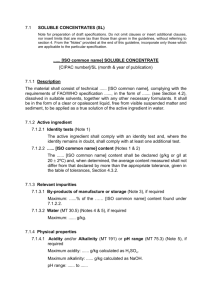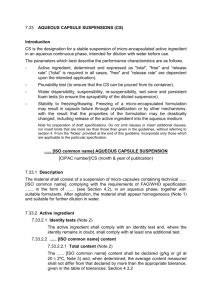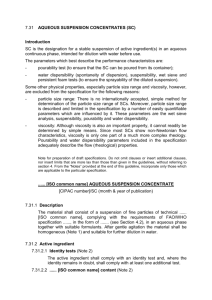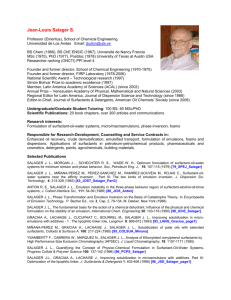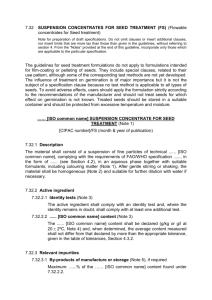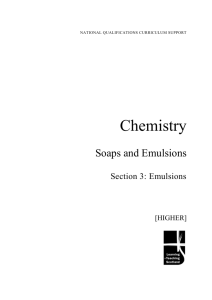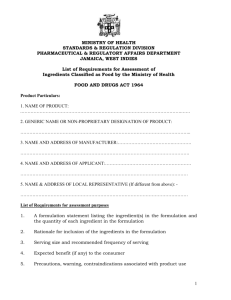water oil
advertisement
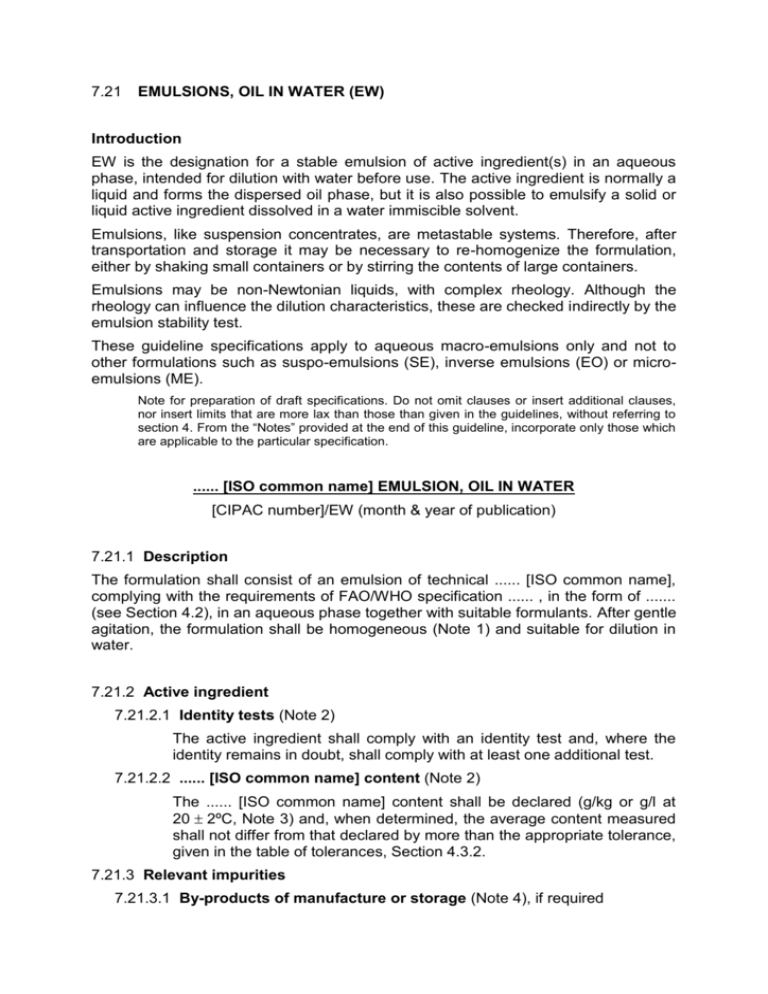
7.21 EMULSIONS, OIL IN WATER (EW) Introduction EW is the designation for a stable emulsion of active ingredient(s) in an aqueous phase, intended for dilution with water before use. The active ingredient is normally a liquid and forms the dispersed oil phase, but it is also possible to emulsify a solid or liquid active ingredient dissolved in a water immiscible solvent. Emulsions, like suspension concentrates, are metastable systems. Therefore, after transportation and storage it may be necessary to re-homogenize the formulation, either by shaking small containers or by stirring the contents of large containers. Emulsions may be non-Newtonian liquids, with complex rheology. Although the rheology can influence the dilution characteristics, these are checked indirectly by the emulsion stability test. These guideline specifications apply to aqueous macro-emulsions only and not to other formulations such as suspo-emulsions (SE), inverse emulsions (EO) or microemulsions (ME). Note for preparation of draft specifications. Do not omit clauses or insert additional clauses, nor insert limits that are more lax than those than given in the guidelines, without referring to section 4. From the “Notes” provided at the end of this guideline, incorporate only those which are applicable to the particular specification. ...... [ISO common name] EMULSION, OIL IN WATER [CIPAC number]/EW (month & year of publication) 7.21.1 Description The formulation shall consist of an emulsion of technical ...... [ISO common name], complying with the requirements of FAO/WHO specification ...... , in the form of ....... (see Section 4.2), in an aqueous phase together with suitable formulants. After gentle agitation, the formulation shall be homogeneous (Note 1) and suitable for dilution in water. 7.21.2 Active ingredient 7.21.2.1 Identity tests (Note 2) The active ingredient shall comply with an identity test and, where the identity remains in doubt, shall comply with at least one additional test. 7.21.2.2 ...... [ISO common name] content (Note 2) The ...... [ISO common name] content shall be declared (g/kg or g/l at 20 2ºC, Note 3) and, when determined, the average content measured shall not differ from that declared by more than the appropriate tolerance, given in the table of tolerances, Section 4.3.2. 7.21.3 Relevant impurities 7.21.3.1 By-products of manufacture or storage (Note 4), if required Maximum: ......% of the …… [ISO common name] content found under 7.21.2.2. 7.21.4 Physical properties 7.21.4.1 Acidity and/or Alkalinity (MT 191) or pH range (MT 75.3) (Note 5), if required Maximum acidity: ...... g/kg calculated as H2SO4. Maximum alkalinity: ...... g/kg calculated as NaOH. pH range: ...... to ...... 7.21.4.2 Pourability (MT 148.1) Maximum "residue": ...... %. 7.21.4.3 Emulsion stability and re-emulsification ( ‡ MT 36.3 ‡) The formulation, when diluted at 30 ± 2°C (Notes 6 & 7) with CIPAC Standard Waters A and D, shall comply with the following: Time after dilution 0h Limits of stability, ‡ , 36.3 Initial emulsification complete 0.5 h "Cream", maximum: ...... ml 2.0 h "Cream", maximum: ...... ml "Free oil", maximum: ...... ml 24 h Re-emulsification complete 24.5 h "Cream", maximum: ...... ml "Free oil", maximum: ...... ml Note: in applying ‡ MT 36.3, tests after 24 h are required only where results at 2 h are in doubt ‡ 7.21.4.4 Persistent foam (MT 47.2) (Note 8) Maximum: ...... ml after 1 min. 7.21.5 Storage stability 7.21.5.1 Stability at 0°C (MT 39.3) After storage at 0 ± 2°C for 7 days, no separation of particulate or oily matter shall be visible after gentle agitation. 7.21.5.2 Stability at elevated temperature (MT 46.3) After storage 54 ± 2°C for 14 days (Note 9), the determined average active ingredient content must not be lower than ......% relative to the determined average content found before storage (Note 10) and the formulation shall continue to comply with the clauses for: - by-products of manufacture or storage (7.21.3.1), - acidity/alkalinity/pH range (7.21.4.1), - emulsion stability and re-emulsification (7.21.4.3), as required. ________________________ Note 1 All physical and chemical tests listed in this specification are to be performed with a laboratory sample taken after the recommended homogenization procedure. Before sampling to verify the formulation quality, the commercial container must be inspected carefully. On standing, emulsions may develop a concentration gradient which could even result in the appearance of a clear liquid on the top (sedimentation of the emulsion) or on the bottom (creaming up of the emulsion). Therefore, before sampling, the formulation must be homogenized according to the instructions given by the manufacturer or, in the absence of such instructions, by gentle shaking of the commercial container (for example, by inverting the closed container several times). Large containers must be opened and stirred adequately. Note 2 Method(s) of analysis must be CIPAC, AOAC or equivalent. If the methods have not yet been published then full details, with appropriate method validation data, must be submitted to FAO/WHO by the proposer. Note 3 If the buyer requires both g/kg and g/l at 20°C, then in case of dispute the analytical results shall be calculated as g/kg. Note 4 This clause should include only relevant impurities and the title should be changed to reflect the name of the relevant impurity. Method(s) of analysis must be peer validated. Note 5 The method to be used shall be stated. If several methods are available, a referee method shall be selected. Note 6 Unless another temperature is specified. Note 7 As outlined in CIPAC MT 36.3, the test concentrations should be based on those in the recommended directions for use supplied with the product. Where several concentrations are recommended, the highest and lowest concentrations, coming within the scope of the method, should be used. Note 8 The mass of sample to be used in the test should correspond to the highest rate of use recommended by the supplier.. The test is to be conducted in CIPAC standard water D. Note 9 Unless other temperatures and/or times are specified. Refer to Section 4.6.2 of this Manual for alternative storage conditions. Note 10 Samples of the formulation taken before and after the storage stability test should be analyzed concurrently after the test in order to reduce the analytical error.
